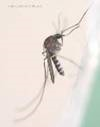Abstract
This small, dark mosquito tends to feed on reptiles and amphibians. It is found in the southeastern United States and many countries in Central America and South America. This 3-page fact sheet was written by Diana Vork and C. Roxanne Connelly, and published by the UF Department of Entomology and Nematology, April 2012.
References
Branch N, Logan L, Beck EC, Mulrennan JA. 1958. New distributional records for Florida mosquitoes. The Florida Entomologist 41: 155-163. https://doi.org/10.2307/3492955
Carpenter SJ, LaCasse WJ. 1955. Mosquitoes of North America (North of Mexico). University of California Press, Berkeley. 361 pp. https://doi.org/10.1525/9780520325098
Clements AN. 1999. The Biology of Mosquitoes: Sensory Reception and Behaviour, Vol 2. CABI Publishing, Oxon, UK. 740 pp.
Cutwa MM, O'Meara GF. 2012. Photographic Guide to Common Mosquitoes of Florida. Florida Medical Entomology Laboratory. http://fmel.ifas.ufl.edu/key/pdf/atlas.pdf (20 February 2012).
Darsie Jr. RF, Day JF. 2003. Studies of the Genus Culex Linnaeus in Florida. I. Redescription of the pupae of Culex nigripalpus Theobald and Cx. tarsalis Coquillett, vectors of St. Louis encephalitis, and a key to pupae of Culex species in the eastern United States (Diptera: Culicidae). Proceedings of the Entomological Society of Washington 105: 100-107.
Darsie Jr. RF, Ward RA. 2005. Identification and Geographical Distribution of the Mosquitoes of North America, North of Mexico. University Press of Florida, Gainesville, FL. 383 pp.
Edman JD. 1979. Host-feeding patterns of Florida mosquitoes (Diptera: Culicidae) VI. Culex (Melanoconion). Journal of Medical Entomology 15: 521-525. https://doi.org/10.1093/jmedent/15.5-6.521
Foote RH. 1954. The Larvae and Pupae of the Mosquitoes Belonging to the Culex Subgenera Melanoconion and Mochlostyrax. Technical Bulletin No. 1091, United States Department of Agriculture. 142 pp.
Galindo P, Carpenter SJ, Trapido H. 1951. Ecological observations on forest mosquitoes of an endemic yellow fever area in Panama. American Journal of Tropical Medicine 31: 98-137. https://doi.org/10.4269/ajtmh.1951.s1-31.98
Marshall SA. 2006. Insects: Their Natural History and Diversity. Firefly Books Inc., Buffalo, NY. pp. 387.
Mattingly PF. 1976. Mosquito eggs XXVIII. Culex subgenera Melanoconion and Mochlostyrax. Mosquito Systematics 8: 19-223-231.
Michener CD. 1944. Differentiation of females of certain species of Culex by the cibarial armature. Journal of the New York Entomological Society 52: 263-266.
Putnam, AH. 2011. Public Health Pest Control Applicator Training Manual. FDACS- Division of Agricultural Environmental Services. http://www.flaes.org/pdf/PublicHealth Manual2011.pdf (23 February 2012).
Roth LM. 1943. A key to the Culex (Diptera: Culicidae) of the southeastern United States, by male terminalia. Journal of the Kansas Entomological Society 16: 117-133.
(WRBU) 2012. Systematic Catalog of Culicidae. Walter Reed Biosystematics Unit. http://www.mosquitocatalog.org/ (23 February 2012).

